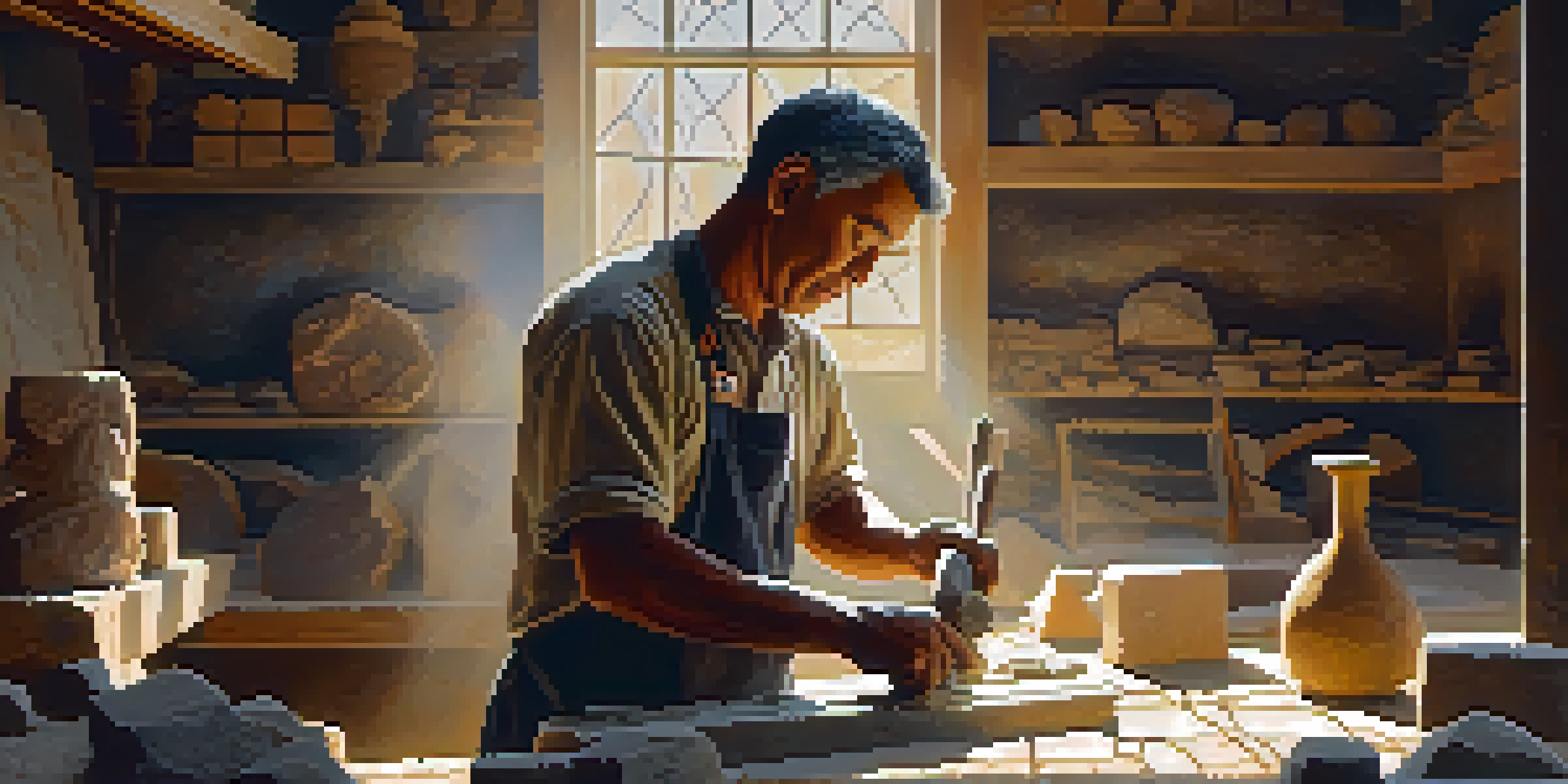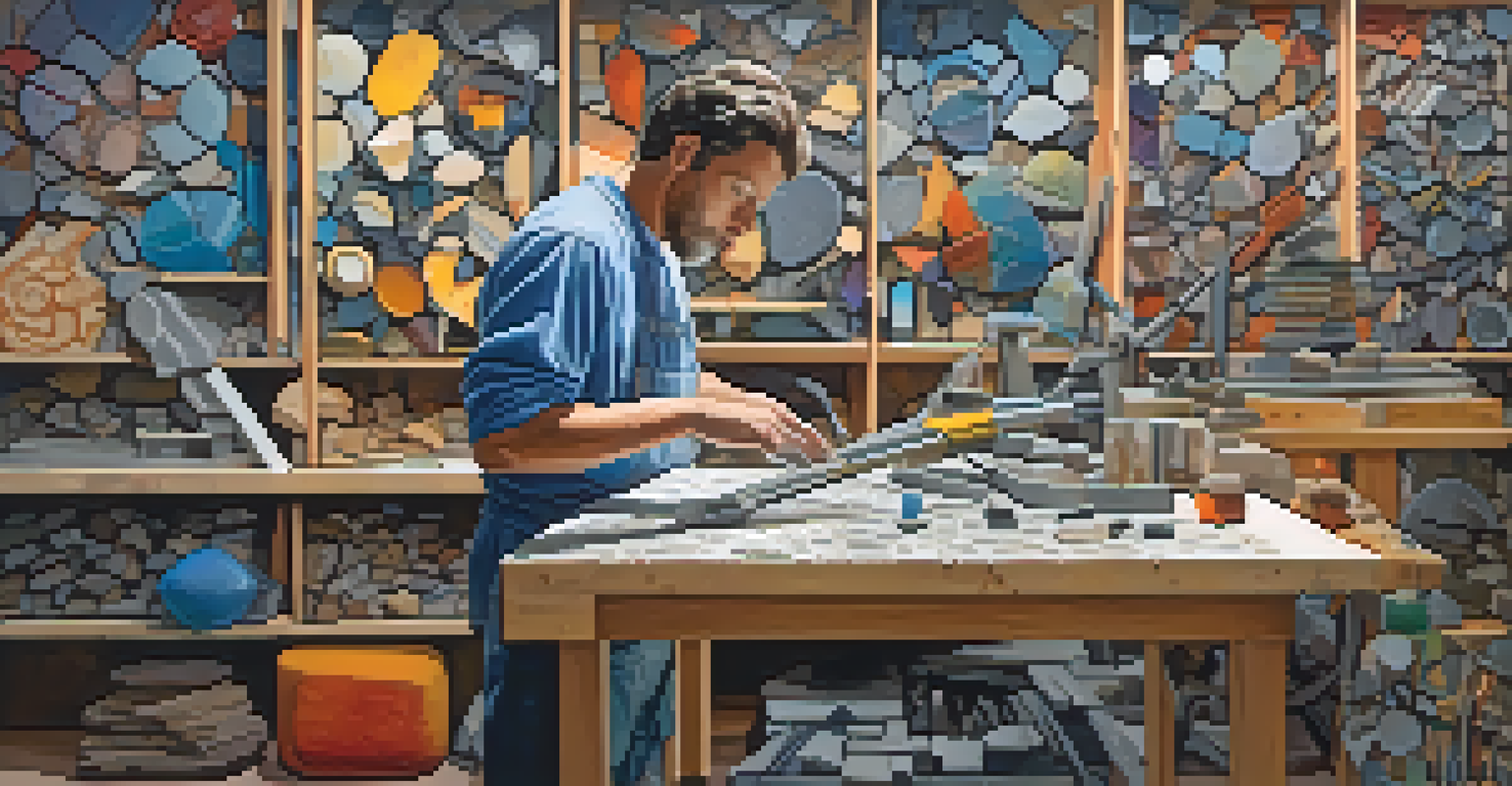Traditional vs Modern Stone Carving Techniques: A Comparison

Understanding Traditional Stone Carving Techniques
Traditional stone carving is an ancient art form that has been practiced for thousands of years. Artists use hand tools like chisels and hammers to sculpt stone, relying on their skill and intuition. This method often involves a deep understanding of the material, as each type of stone has its unique properties and challenges.
Art is the most beautiful of all lies.
The process is labor-intensive and requires patience, as artists can spend weeks or even months perfecting a single piece. The connection between the artist and their medium is profound, often leading to a sense of reverence for the stone itself. This technique is not just about creating art; it's about honoring the traditions passed down through generations.
Many traditional stone carvers also emphasize the importance of form and detail, often creating intricate designs that tell a story or convey a message. The final product is a testament to the artist's dedication and skill, reflecting a timeless beauty that modern techniques sometimes struggle to replicate.
Exploring Modern Stone Carving Techniques
In contrast, modern stone carving techniques have embraced technological advancements, making the process more efficient and accessible. Tools like electric saws and diamond-tipped blades allow artists to cut through stone with precision and speed, reducing the time needed to complete a piece. This shift has opened up new possibilities for creativity, enabling artists to experiment with shapes and designs that were once difficult to achieve.

Modern techniques also often incorporate mixed media, allowing for a fusion of materials that can enhance the final artwork. Artists can combine stone with glass, metal, or even digital elements, pushing the boundaries of traditional stone carving. This blend of old and new not only brings fresh perspectives to the art form but also attracts a younger audience.
Traditional vs. Modern Techniques
Traditional stone carving emphasizes craftsmanship and heritage, while modern methods leverage technology for efficiency and innovation.
However, some purists argue that this shift may dilute the essence of stone carving, as the reliance on machinery can lead to a disconnect between the artist and the stone. While modern methods offer efficiency, they sometimes lack the tactile experience and personal touch that characterize traditional carving.
Comparing Tools: Traditional vs. Modern
The tools used in traditional stone carving are simple yet effective. Basic hand tools, including chisels, mallets, and rasps, allow artists to carve with precision and control. This method encourages a more personal interaction with the stone, as each strike of the chisel is deliberate and intentional.
Every artist dips his brush in his own soul, and paints his own nature into his pictures.
On the other hand, modern stone carving tools have revolutionized the way artists approach their craft. Electric tools like grinders and pneumatic chisels enable faster and more uniform cuts, allowing for the creation of complex shapes with relative ease. This advancement has made stone carving more accessible to those who may not have the time or physical capability for traditional methods.
While both sets of tools have their advantages, the choice often depends on the artist's vision and style. Traditional tools foster a deep connection between the artist and their work, while modern tools can facilitate innovation and experimentation in artistic expression.
The Role of Materials in Stone Carving
The choice of stone is crucial in both traditional and modern stone carving, as different types of stone offer various textures and colors. Traditional carvers often work with marbles, limestones, and sandstones, each providing unique characteristics that influence the final outcome. The natural veins and imperfections in the stone can add depth and history to the artwork.
Modern carvers also have access to a wider range of materials, including engineered stones and composite materials. These options can mimic the appearance of natural stones while offering enhanced durability and ease of manipulation. This versatility allows for more creative freedom, enabling artists to explore unconventional designs that challenge traditional aesthetics.
Importance of Material Choice
The selection of stone significantly influences the artistic outcome, with traditional carvers favoring natural materials and modern artists exploring engineered options.
Ultimately, the material choice reflects the artist's intention and vision, whether they prefer the authenticity of natural stone or the innovation of modern composites. It's a fascinating aspect of the art form that continues to evolve as new materials and techniques emerge.
Artistic Expression: Tradition vs. Innovation
Artistic expression in traditional stone carving often revolves around themes of heritage and cultural significance. Many artists draw inspiration from their surroundings, infusing their work with local stories and traditions. This connection to the past is reflected in the techniques used, as artists strive to honor the customs of their predecessors.
In contrast, modern stone carving encourages artists to break free from conventions and explore their unique styles. The use of technology and mixed media allows for a more personal expression, often resulting in abstract or conceptual pieces that challenge viewers' perceptions. This shift has led to a more diverse range of artworks that can resonate with contemporary audiences.
However, the debate between tradition and innovation continues to spark discussions among artists and enthusiasts alike. While some advocate for preserving traditional methods, others embrace the opportunities that modern techniques present, highlighting the dynamic nature of artistic expression in stone carving.
Preserving Traditional Techniques in a Modern World
As modern techniques gain popularity, there is a growing concern about preserving traditional stone carving methods. Many artists and organizations are working to keep these age-old techniques alive through workshops, apprenticeships, and community programs. By sharing knowledge and skills, they aim to ensure that future generations can appreciate and practice this art form.
These efforts are crucial, as traditional stone carving carries a wealth of cultural and historical significance. Each piece created through traditional methods tells a story, reflecting the values and beliefs of the time it was made. By maintaining these techniques, artists contribute to a richer understanding of our artistic heritage.
Preserving Artistic Heritage
Efforts to preserve traditional stone carving techniques are vital for maintaining cultural significance and ensuring future generations can appreciate this art form.
In a world that often prioritizes speed and efficiency, the commitment to preserving traditional techniques serves as a reminder of the beauty found in craftsmanship and dedication. It's a testament to the enduring power of art to connect us to our roots while inspiring us to innovate.
The Future of Stone Carving: A Harmonious Blend
Looking ahead, the future of stone carving may lie in finding a balance between traditional and modern techniques. Artists are increasingly recognizing the value of blending these approaches to create unique and meaningful artworks. This harmonious fusion can result in pieces that celebrate the past while embracing contemporary innovation.
Additionally, as technology continues to evolve, new tools and methods will emerge, offering endless possibilities for artistic exploration. Artists who are willing to adapt while maintaining a strong connection to their roots are likely to thrive in this new landscape. This adaptability will allow for the continued evolution of stone carving as an art form.

Ultimately, the future of stone carving will depend on the passion and creativity of the artists who practice it. By respecting tradition while embracing modernity, they can create works that resonate across time, bridging the gap between generations and inspiring future artists to continue the legacy of this timeless craft.